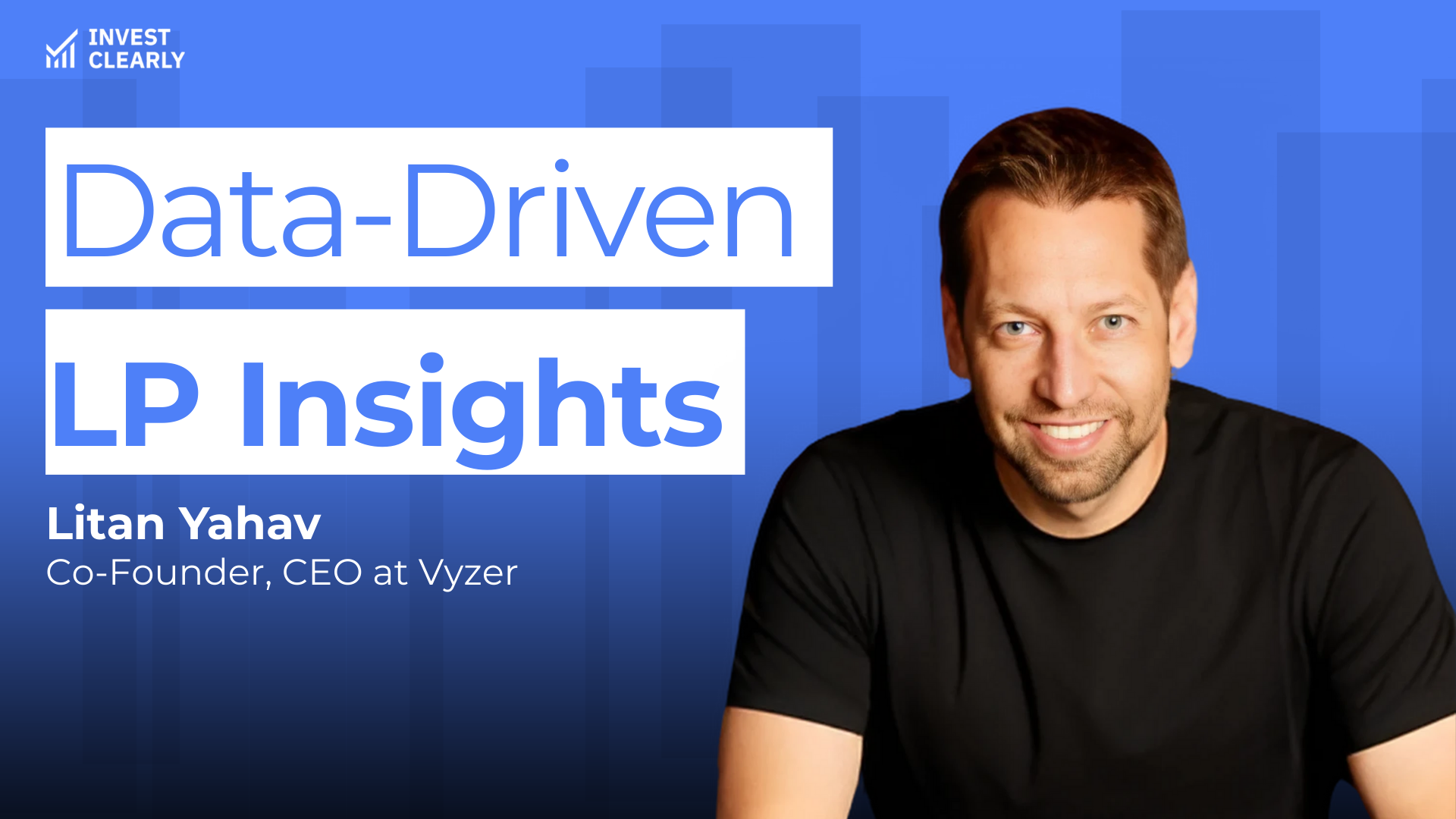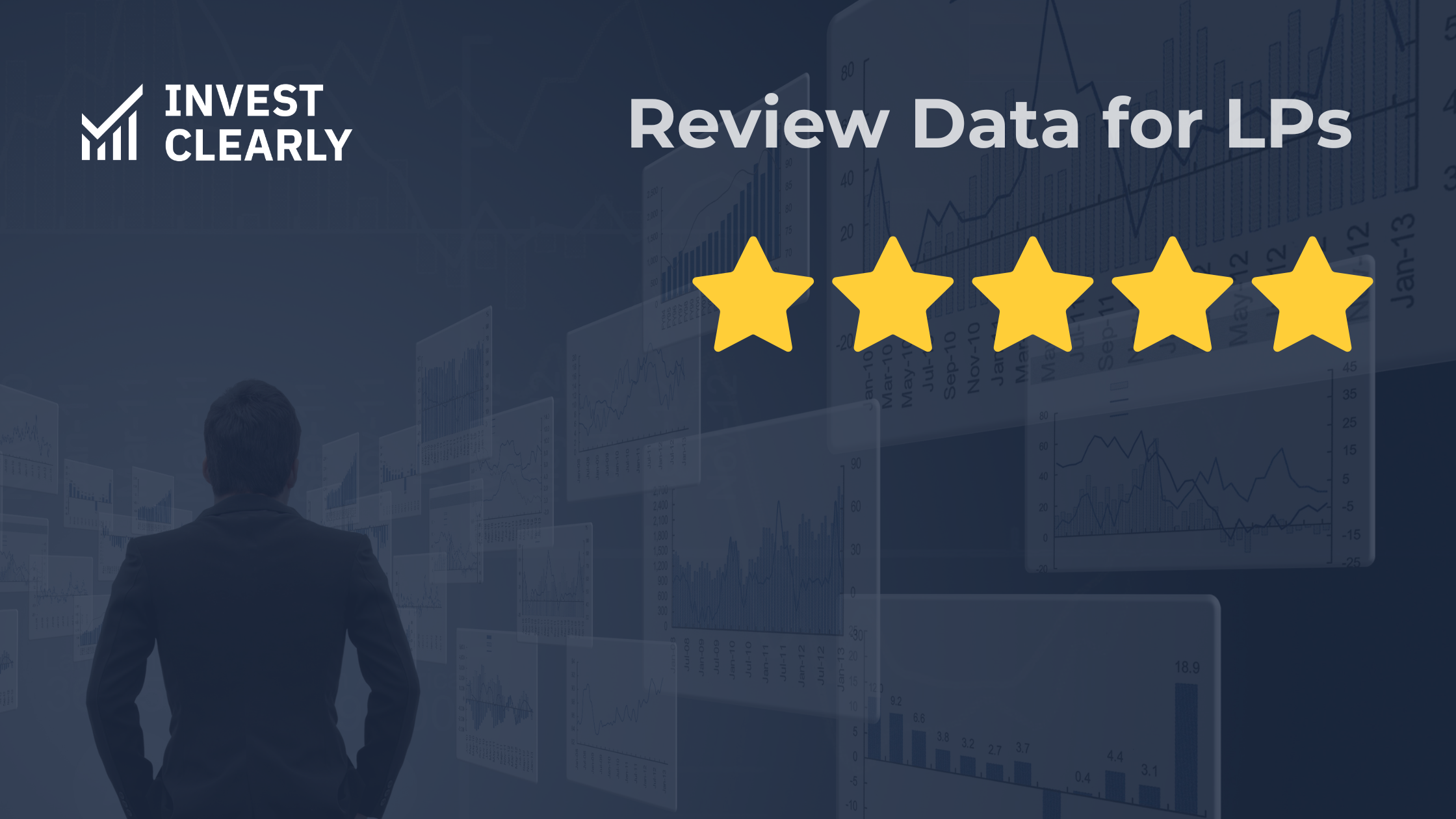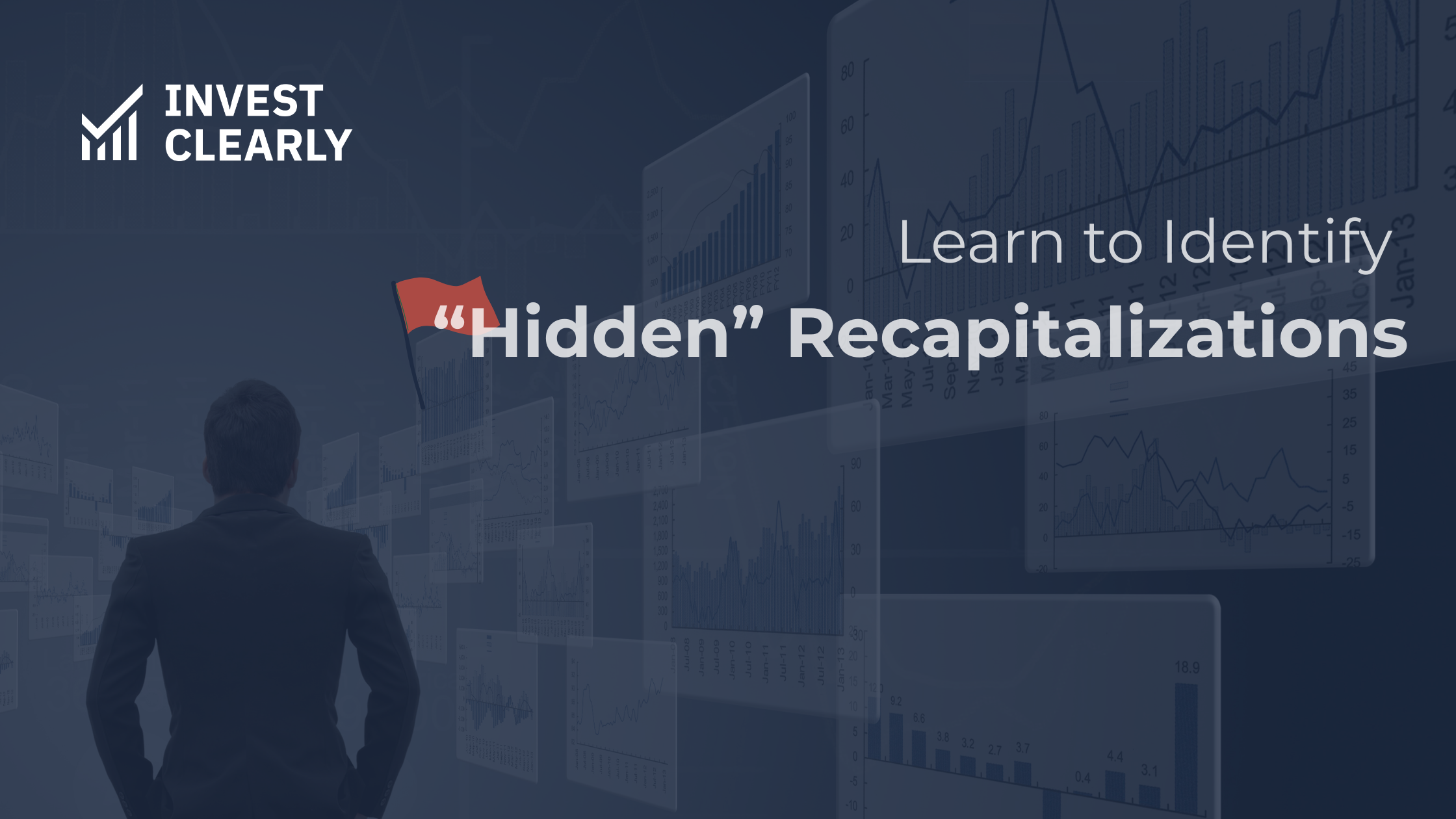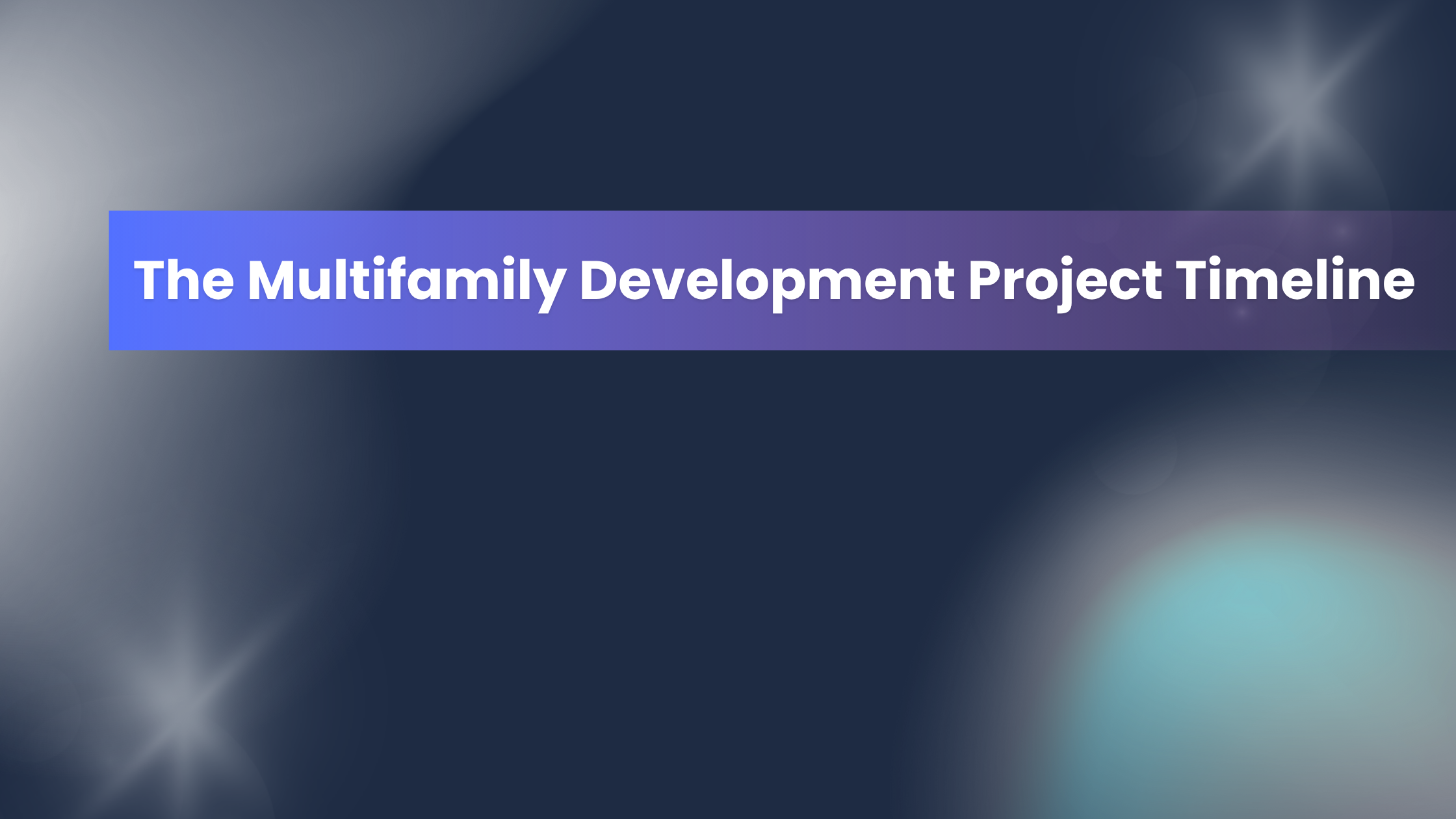
What Billions of Dollars in Data Reveal About Today’s Market with Litan Yahav
Never miss an Invest Clearly Insights article
Subscribe to our newsletter today
In this conversation, Litan Yahav, co-founder of Vizor, shares insights on the evolving landscape of investment strategies, particularly focusing on the cautious approach of Limited Partners (LPs) in today's market.
He discusses the shift from equity to debt investing, the appeal of high-risk, high-return opportunities, and the importance of transparent communication between General Partners (GPs) and LPs. Litan also explains the value of Special Purpose Vehicles (SPVs) and how they can benefit investors. The discussion highlights the differences in decision-making between retail and institutional investors and emphasizes the need for better communication in passive investing.
What Billions of Dollars in Data Reveal About Today’s Market with Litan Yahav
[00:00:00] You're seeing a lot of GPs going under, taking their LPs with them and just ghosting everyone. We all talk about passive investing, but passiveness is a spectrum. It's not binary. If I'm investing two times the time in an investment, I want two times the return. LPs are still looking to invest. They're just a lot more cautious. And there are others where people say they haven't hit projections, but they're communicating. I'm confident. They just want to know what's going on.
[00:00:27] Intro: Welcome back to the Invests Lee Podcast. I am your host and CEO of Invests Clearly, Pat Zal. In today's episode, we sit down with Litan, a tech founder and limited partner who spent the last decade navigating private markets and building Visor, a platform for managing complex portfolios. We talk about risk-reward trade-offs, sponsor underwriting, and why the structure of a deal should reflect the experience of the operator. Litan also shares what he's observing across thousands of portfolios that may be contrary to what you think, and what he believes needs to change in how GPs handle communication when things go wrong. Let's get into it.
[00:01:17] Pat: All right, Litan, thank you for joining us. Before we get started, take a little bit just to talk about your background, tell us about Visor, what you guys are doing, and then we'll hop into it from there.
[00:01:29] Litan: Yeah man, I'm excited. Congrats on the new show.
[00:01:32] Pat: Yeah, thanks.
[00:01:32] Litan: I'm happy to be here. Quick background: I'm a tech founder, sold a company, made some money, been investing that money over the past decade, me and my co-founder. Predominantly into real estate syndication as an LP, but other types of investments as well. About five years ago, I had the good problem of managing all these investments and decided to build a platform to manage our own stuff—just to automate, consolidate, and get transparency into what we have without having to work hard on managing it. That evolved into a new company called Visor, which is what we operate today. We focus on helping high net worth individuals and family offices track and manage complex portfolios and reducing the back office overload of admin stuff with a front office iPhone-type experience—automating all the back office so you don't have to hire staff. It could be an assistant or a whole team, but with a really good front-end user experience. We've been doing that for the past couple years. Currently helping a couple thousand clients with tens of billions of assets tracked, and it's really interesting to see how the industry has been evolving over the past couple years.
[00:02:46] Pat: Awesome. With all this visibility, all these data points, and talking about how the industry has been evolving, what are you seeing from the LP decision-making standpoint based on what's going on with GPs?
[00:03:02] Litan: It's funny. LPs are still looking to invest.
[00:03:04] Pat: Yeah.
[00:03:05] Litan: They're just a lot more cautious. It's already common knowledge, right? Three or four years ago it was really easy to find deals. Then zero interest rates were completely thrown out the door. Now it's hard to do deals, and deals that you're in are screwed. So the LPs got a lot of bad experiences—which is an understatement—with the investments they made, and now they're more cautious about either redeploying capital in the same asset classes with the same GPs, deploying capital elsewhere, or just sitting on it and waiting. We're still seeing people deploy capital. It's larger checks to fewer operators. Public markets, which is interesting, have become more prevalent. We did a report where Q1 of this year showed a 70% increase versus Q1 of the previous year into public markets. So new deployed capital has been going to public markets, not private markets.
[00:04:23] Pat: Are you seeing trends more than just into public markets? Maybe shifting from mainstream assets to niche asset classes? Do you guys follow things like that?
[00:04:41] Litan: We follow everything. We take a really holistic approach to finances. In public markets, we don't really go down to the details—I don't have data on hand for exactly within public markets where people are deploying. In private markets, which is more interesting because there's no transparency, we've been looking into that more than the publics. There are all these notions we've been hearing in the market, but when you open up our data, you see it differently. Over the past couple years there's been a transition from equity to debt investing—people going into debt funds and stuff like that. We've actually seen a decrease in that space over the past couple quarters into the private debt landscape, specifically debt funds. I would've assumed there would be an increase, but actually a decrease. That's number one.
Number two: in the multifamily space, which has also been hit hard over the past couple years—that's the entry level for most LPs who touch syndications. I think it's like 70% of all real estate investments on our platform have been in multifamily. You've heard about a decrease in multifamily over the past couple years because people have been affected. But there's actually been a jump back up. Within the private space, which as a whole has decreased, there's been an increase in multifamily investments over the past couple quarters, which is also really interesting and surprising for us to see.
[00:06:23] Pat: That's super interesting. And you're in a unique position, especially compared to many LPs that listen to the show. Are you making investments right now or are you strictly focused on building Visor?
[00:06:38] Litan: Both. I am making investments and I'm very focused on building Visor. For us personally, for me, I'm interested in more than the multifamily space just because of the returns. I think multifamily is a solid investment. I'm just looking for higher risk, higher returns, so I look more at other types of stuff.
[00:07:03] Pat: Where are you getting those high risk, high returns from?
[00:07:06] Litan: Development-type deals, hard money lending, triple net industrial stuff, oil and gas. Those have been—people obviously are going to argue if it's higher risk—but the way I see it, if there's higher reward, there has to be higher risk, or else it doesn't really make any sense. I mean, yeah, there's some arbitrage, but when you look at multifamily, which is commercial but very residential at its core, people are going to need places to live, so I think that's lower risk than a single tenant net lease of a warehouse.
[00:07:44] Pat: A lot of people have been bringing up industrial. A lot of people bring up industrial as one of the safer asset classes right now. But a lot of people on the show have been bringing up oil and gas. I've heard a lot of people really focus on that lately. Are you mainly on the tax play side of things, or what's your approach to that? Is it just a diversified asset class where you're going to put stuff in here, or what's got you interested in that?
[00:08:13] Litan: Not all oil and gas investments have the tax benefits, and it's really important for people to ask those questions. If you're investing in a fund, you don't always get that depreciation. It's important to emphasize that. For me, it's more—there's two aspects. Number one, we have an energy crisis in the world and in the US particularly, right? We're at a deficit of energy. I think people are interested in energy because of that. And then in oil specifically, we're a huge exporter now of oil. The US has become one of the largest exporters of oil around the world. So that's an opportunity, and also diversification across all asset classes. So maybe that's why it's more interesting.
The cash flow is supposed to be extremely high. The IRR is supposed to be extremely high. When you compare it to other asset classes like multifamily, which is I'd say 12 to 14% IRR and 6-7% cash flow, you look at oil and gas and it's almost double. That's just appealing. And then when you look at the alternatives, let's just say you go back to debt funds. When you're getting debt funds that have liquidity and 10-11% IRR, and then you compare that to a multifamily deal—which is a different risk profile—but it's a bit higher returns. Some people just don't want to take that added risk to get 12 to 14, 15% IRR.
[00:09:54] Pat: I'd love to dive more into that risk profile a little bit more. You're the first person who has really brought up the high risk, high reward side of things. When you're evaluating these high risk, high reward opportunities, what are you looking at differently than safer, more traditional opportunities? Are you underwriting sponsors harder or more leniently? Are you underwriting deals more leniently, or is it just getting to a point where it's an understanding—this is the risk factor and I'm okay with that—and move forward? What does your due diligence look like on these sponsors and deals?
[00:10:31] Litan: For us, because we're in this unique position, we also have access to the data of the actual performance of people who've invested with these operators. That helps give more clarity and transparency. There's also their own self-reported performance and historic performance. And then there's just the sponsor itself—how big they are, how experienced they are—and it just changes the risk, right? If you're investing with a sponsor who's been around for 30 years and their track record is like 90 full-cycle deals, this is a very experienced sponsor. Risk is lower than a sponsor who just started yesterday.
Usually that experience comes also at a premium. That sponsor, because they're so experienced, because it's relatively easier for them to raise capital than the inexperienced sponsor—the terms also match that. That's what I mean by premium. So it's a trade-off. That's where risk comes in, and then the reward as well. Fees, waterfall splits, prefs—all that is different when you're investing with an inexperienced sponsor.
Now, sometimes you'll find inexperienced sponsors. Maybe they worked somewhere and they have the experience, or maybe whatever it is, but they feel like they have the experience of an experienced sponsor, and they'll have terms similar to that of an experienced sponsor. That for me personally is a red flag because there's still risk. You might be a really good operator at operating a multifamily deal or whatever it is, but you've never raised capital from an LP before. There's a whole complexity derived from that that adds risk. Not to mention how lenders see you and how brokers see you. It's just very different, I think, analyzing that type of stuff.
And then there's the deal level risk, which is if I'm investing in a development deal, there's a different risk profile than in a multifamily value-add deal than in oil and gas. All these things have different risk profiles, and the returns need to match that as well. If I'm investing in a development deal and the returns are in the mid-teens, it's just not worth the risk for me. Same goes for the comparison between a multifamily and a debt deal.
That's the way I see the risk-return aspect of it. And I always add another level: there's risk, there's reward, and there's the time that goes into it. Because a lot of people are active real estate people. They flip homes or they do their own deals and they're GPs on their own, and then they compare—wait, hold on, look what they're doing. I can do the same thing. Why would I invest as an LP if I can do this as a GP? I just think it's always important to take into account the time and effort that goes in on top of the risk-reward, because that's also a spectrum when it comes to passiveness of a deal.
[00:13:54] Pat: Yeah.
[00:13:54] Litan: We all talk about passive investing and all that BS, right? And then you come to understand, well, it's not really passive. I just say passiveness is a spectrum. It's not binary. If I'm flipping homes, that's extremely active. There's nothing passive about that. If I'm an owner of long-term rentals and have a property manager, it's not as active as flipping, but it's also not as passive as being an LP. I put in real estate, at least on one side, flipping homes, which is the most active kind of real estate I think you can do. And then on the far other side of passiveness, which is completely passive—if you want to consider publicly traded REITs as real estate—that's probably the ultimate passive investing in real estate. So you put these things on the spectrum, and then you add that on top of the risk-reward that you're getting into. And for me, if I'm investing two times the time in an investment, I want two times the return to any other type of investment. So I always add the time aspect to the risk-reward analysis.
[00:15:07] Pat: That's super interesting. I really liked the terms-per-experience thought process. Most of the people that I've had on the show and I engage with say it's like track record or bust. It's not like the terms should reflect the track record and therefore give the newer operator more of a shot because it's more favorable. So that's really interesting.
[00:16:13] Pat: One thing I want to talk about: last time I met with you at Best Ever Conference, you were really focused on the SPV strategy. We were talking off-show, and you said you had stopped doing that. Will you help us understand what an SPV is? The value of it, and then ultimately what made you pivot away from that strategy?
[00:16:34] Litan: Sure. As I mentioned, we help thousands of families track and manage their wealth, and that has resulted in tens of billions of assets tracked, which has also resulted in this huge data set that can bring a ton of value to people. We've had our clients reaching out over the years asking us, "Can you tell us who the good operators and GPs are?" because we see the data. We've always said, "Listen, we don't want to go down that rabbit hole. No."
Then at the end of last year, 2024, we decided, "Hey, well, why not?" We did a test where we said, "All right, we saw this great operator on our platform, and they're raising capital. Let's have them come and pitch a deal. We'll back them with the data that we have, and if it makes sense—we obviously don't want any conflict of interest, so we don't charge anyone for that—and if it makes sense, we'll put together an SPV so that we can offer our clients a lower minimum and get better terms as we pool capital together." It's a win-win-win. It's a good sponsor because we see the data, it's a good deal, and also we get the best terms because we pool capital together. That's why we started to put together these SPVs.
That first use case was a success. So we started to do more of those: bring good operators, pitch the deals, if it made sense, put together SPVs. People wrote a $50,000 check and they got $5 million terms. We took a small management fee just for the SPV just to cover the cost of the SPV itself.
An SPV—just for clarification for people who don't know—an SPV is a special purpose vehicle. It's basically you create a legal entity, a company, where everyone who invests in the company is basically a partner. And then that company together invests as one check into the bigger one. So if a GP is raising capital and the minimum ticket is $100,000, and if you invest $100,000 your pref is 8%, but if you invest a million your preferred return is 10%, then it makes sense. I'd want to write a million-dollar check. So we raised capital into this SPV, created a minimum that's not even $150,000, so that people can pool capital together to invest together into this opportunity to get the million-dollar terms.
We did that a couple times, and then we just found that it was bringing value, but we spent so much effort and time doing it, and it just wasn't worth our while to do that because we're a tech company and we need to focus on our tech and not on that. Although it brings value, we're just not at that point where we can split our mindset and bandwidth to do both.
And second, and this is really important and interesting—I have conversations with GPs around this a lot—this environment, capital raising environment, requires GPs to be creative. It's difficult to raise money. So when you put together a deal, a fund, or whatever it is, you need to find a way to make that deal attractive to people who write bigger checks. When you think about, for example, the wealth management, RIA space, who can pool capital together to write a big check, they need to be incentivized to do that for their clients, and the GP wants their clients. So what GPs—if they want to build their strategy properly—they need to make sure when they set up their structures to split the shares, to create different share classes where if I'm writing a $100,000 check, I get specific terms. If I write a million-dollar check, I get better terms. If I write a $5 million check, I get even better terms.
I was really shocked that not all GPs or operators think that way. I've met many, many GPs: if you write a $50,000 check or a $5 million check, you get the same exact terms.
[00:20:29] Pat: Yeah.
[00:20:30] Litan: And I think that doesn't make any sense, unless you're a GP that just gets money thrown at you and you don't care.
[00:20:38] Pat: Sure. So do many retail LPs know about this strategy? I've talked to quite a few people that run co-investing clubs, which I'm assuming is a version of an SPV. They're coming in with checks, they're pooling it together under one LLC. But why don't more people take this route to get better terms? Is it just an unknown strategy or not mainstream enough?
[00:21:06] Litan: Well, it's just hard. And also you have to have someone be the point of contact, and that's work.
[00:21:10] Pat: Fair enough.
[00:21:11] Litan: It's hard. And also there's regulatory compliance that goes into it as well.
[00:21:22] Pat: Yeah. Okay, that makes sense. That was just a sidebar question. We don't have to go too deep into it. But I'd love to dive a little more into Visor and sort of what you're seeing and the value you provide LPs. So it's the wealth management side of things. Do LPs get certain indicators on trends in certain asset classes, besides just how their finances are being benchmarked against others? For example, you talked a lot about the trends in multifamily, the trends on debt, some of the other things. Are they being notified on these types of things as a user?
[00:22:04] Litan: Yeah, they are. We're not doing it inside the product itself yet. This is more offline where we create a webinar and walk people through the trends that we're seeing. We do show our clients benchmarks to other people like them in the platform—anonymized, aggregated data—so they can see how people allocate their wealth in each asset class, which platforms, managers, GPs are other people investing in, how much money's invested in each of those. So there's some level of insight that at the moment are pretty high level, but the plan is to go deeper on that.
And also on the wealth management side of it, because we are holistic, we've also started working with advisors, wealth managers, who then just offer Visor as a benefit to their clients. So they'll operate on Visor to communicate the aggregate wealth, to create that reporting for their clients as well. And it also helps them give more insights to their clients. We've also had AI on top and on the bottom of our platform. On the bottom of the platform, we have a foundation of artificial intelligence that analyzes data, pulls data from any source, extracts it, creates or updates assets and liabilities on our platform—extremely robust, probably the most advanced in the market. That's on the bottom of the platform.
And then on top of the platform, there are two ways to interact with data. There's the conventional user interface—UI, UX—that most tech platforms have. So we have that component where you can interact with your data, but there's a whole other component on top of it where you can just interact with your data in a ChatGPT style. So we pull in your data and we pull in the market data, so you can interact and ask questions about that—how you are compared to trends in the market and so on. There are multiple ways we're trying to add value on the trend standpoint, on the data standpoint, on market trends as well. There's a lot of aspects to it.
[00:24:01] Pat: Sure. You mentioned earlier you're advising GPs on how to structure deals creatively to attract larger capital from the institutional guys. And you also just mentioned working with wealth managers. Based on some of these trends you're seeing within advisors, are you seeing a difference in decision-making between the retail investor and the larger institutional or how wealth managers are making decisions? What I mean by that is, obviously these larger players are much more resourced than the individual person who finally put together $50 grand or just hit the accreditation status. What strategies are the larger players deploying that the retail people may not be aware of?
[00:24:47] Litan: The larger players obviously have access to larger capital, larger checks, and also to larger players in the market. In terms of private equity firms, most of us retail investors are probably not investing in the Blackstones, the KKRs of the world, the Carlyles, unless we're getting to a feeder that's super expensive because the minimums are high. A lot of the things these wirehouses tend to have is access to these bigger funds. And then you also see the wealth management space trying to find good opportunities for their clients because everyone wants to provide an edge. So they are going deeper and lower into the value chain, to the lower-tier operators, the ones we're talking about that are more retail-oriented. And that's where you guys are providing value and transparency—how can they choose the good sponsors—where we hope to also provide value so they can see how other advisors or other clients are investing, so they can bring the best deals to their clients.
There's no doubt that the wealth management industry is trying to find that edge in the private markets because it's always a competition of how do I create more value for my clients. So does that answer your question?
[00:26:03] Pat: Yeah, yeah. I always wonder, what do the big guys know or are doing or are trending towards that the little guys are unaware of? Because there is a gap. I mean, you see it in the fees and the structures. There's preferential treatment with size. But from a knowledge and research standpoint, I wasn't sure if there was anything that these guys are waiting on, these guys are avoiding, these guys are seeing that the retail people aren't, that they could know more about to make their decision-making process better. So yeah, no, that was a great answer.
All right, I know we're kind of leaning towards the end of the call. We're going to ask my favorite question that I ask everybody: What part of passive investing do you think needs to die?
[00:26:49] Litan: Oh man, that's a deep question. Needs to die. I think the notion that everything passive is passive.
[00:27:03] Pat: That's been brought up a couple times.
[00:27:05] Litan: Oh, really? Let me think about something else then.
[00:27:08] Pat: Why? Tell me why. We could stick with that one. Tell me why you feel that way.
[00:27:12] Litan: Well, just because it's an illusion that people think everything's passive when it's not. People talk about passive income all the time, but they never talk about what that even means. I mean, passive is not always passive. But yeah, that's a great question. You got me.
[00:27:35] Pat: Sorry. Yeah, it's meant to get people thinking. Well, let me reframe it as: What do you thoroughly dislike about the industry right now? Maybe something going on? One answer that we had recently was just people not really fully being aware of the capital stack—how common equity could be wiped out without the asset going to zero. Another person brought up negative leverage. Another person brought up the pref equity deals that aren't actually being transparent that it's rescue capital. I didn't know if there was anything—
[00:28:09] Litan: Let me give you one. I assume people have talked about this as well, but I also think it's really important. You can have bad things happen in a deal as a GP and still be okay with your investors. It kind of feels like recently you're seeing a lot of GPs going under, taking their LPs with them and just ghosting everyone. I think that, at least for me as an LP, when I invest, I know there's risk. It sucks when something happens, but there's always risk. And I'm a tech entrepreneur. I have investors. Things aren't always going amazing, and I have to communicate that properly so they're transparent and they know. Investors are not going to get mad at me. They might be disappointed, and I understand that and respect it. They're not going to get mad at me. It's a risk. It happens. That's life. As long as I'm a straight shooter, I'm not lying, I'm not stealing anyone's money.
The same goes for any GP. Shit happens. Yeah, interest rates—I made a mistake as a GP. I made a mistake. And I think that GPs ghosting LPs—because I see that across the board over the past year or two—is just wrong. Own up to your mistakes, your failure. Communicate it properly. People will be disappointed. They might not invest with you again, but at least your morals aren't hit and you're not going to get sued. But at least you're not lying. And I just hear more and more—and that needs to die—GPs that are just morally in the wrong place. There needs to be a measure to know, "Hey, is there a risk this guy's going to lie to me if the shit hits the fan?"
[00:30:02] Pat: Yeah.
[00:30:02] Litan: Everyone always says, you know, you're always betting on the horse, and the sponsor is the horse in this case. And you want to make sure that they're going to be legit. They're not going to steal your money. They're not going to lie to you. That's number one.
[00:30:16] Pat: Yeah. It's funny that that tracks so much to what I'm seeing as well. When I talk to LPs and they're looking at a total loss of capital, I brought this up with somebody else—they'll bring that up with me for like 10 seconds on the call, and then they'll talk for 45 minutes about how they're not being communicated to about it. It's a wild concept where nobody's excited about losing money or their investment going to zero, but they really care more about the fact that they don't know what's going on. This could be performing well. This could be terrible. They just wish these guys would answer. And it tracks. In our reviews, we track pre-investment communication against post-investment communication. The five-star to pre-investment to one-star to post-investment tracks against every negative review. And then there's others where people say they haven't hit projections, but they're communicating. I'm confident. They just want to know what's going on.
But Litan, thank you so much for joining me. If people want to know more about Visor or find you, where should they go?
[00:31:17] Litan: Yeah, I'm pretty active on social media—LinkedIn, Facebook, Instagram. Litan Yahav, you can reach out. Visor is V-Y-Z-E-R dot co. So it's bad naming, but hopefully you can find it. V-Y-Z-E-R dot co. And happy to chat with anyone interested in passive investing.
[00:31:35] Pat: Awesome. Litan, thank you so much for coming on.
[00:31:38] Litan: Thanks for having me, man. Appreciate it.
Written by
Invest Clearly empowers you to make informed decisions by hosting unbiased reviews of passive investment sponsors from verified experienced investors.
Other Articles

Investor Experience Index Q3, 2025: LP Takeaways
Discover quarterly insights of how LPs rate their experiences with GPs. Get data-driven questions to use when evaluating GPs.

Real Estate Recapitalizations—What Passive Investors Need to Know
A recapitalization is a restructuring of a property's capital stack (the mix of debt and equity that finances an investment). While they can be legitimate business strategies, transparency can be an issue.

How to Evaluate a Potential Investment Using the FUND Framework
The FUND framework is a simple way to evaluate opportunities by looking at four pillars: Financials, Underlying Assets, Notable Differentiator, and Delegation of Responsibilities.

What Needs to “Die” in Passive Investing – According to Guests of The Invest Clearly Podcast
Get the answer to the closeout questions of each podcast episode: “What do you think needs to die in passive investing?” The answers are wide-ranging, from misconceptions about risk, to misleading marketing tactics, to structural issues in how deals are presented.

Passive Real Estate Investing Advice from Experienced LP Investors
Experienced LPs shared their most valuable lessons, drawn from years of investing across various asset classes and sponsor relationships.

From Land to Lease-Up: The Lifecycle of a Multifamily Development Deal for LPs
This guide walks you through the typical timeline of a multifamily development project from the LP perspective. Learn when investors come on board, what happens during construction and lease-up, and how profits are realized at exit.